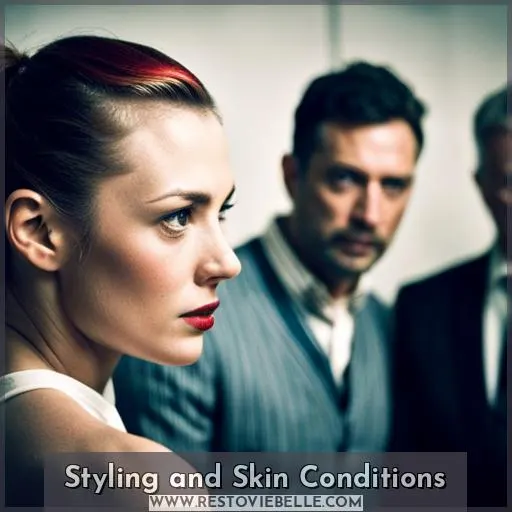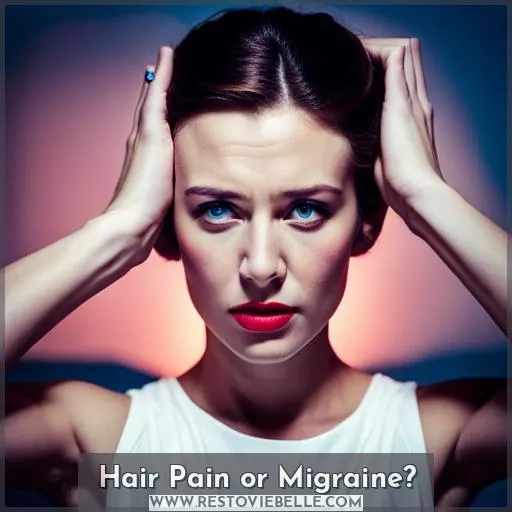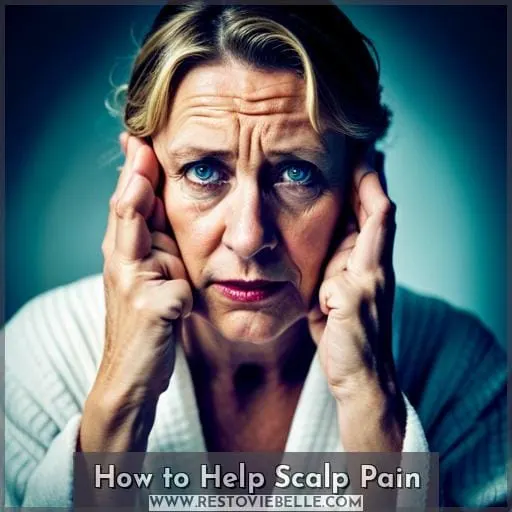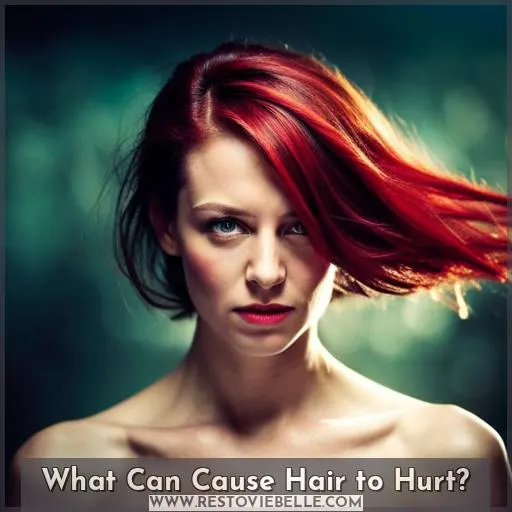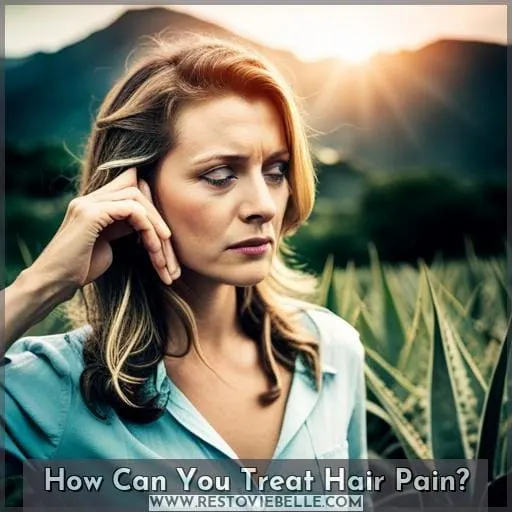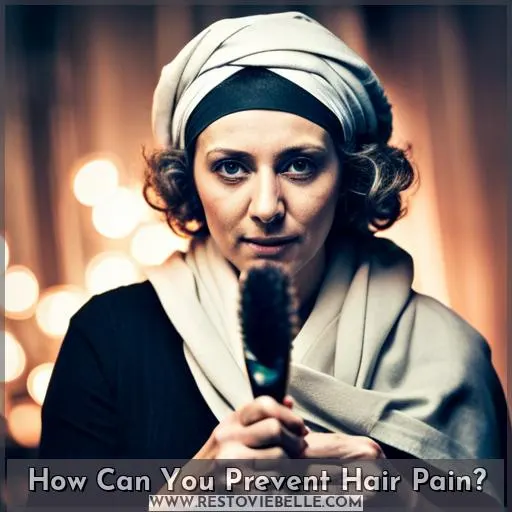This site is supported by our readers. We may earn a commission, at no cost to you, if you purchase through links.
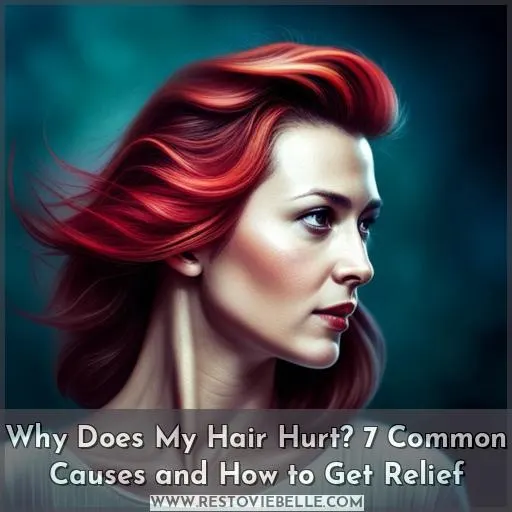 Have you ever wondered why your hair hurts? You’re not alone. Hair pain affects up to 80% of people, and there are many possible causes, from styling habits to medical conditions. In this article, we’ll explore the 7 most common causes of hair pain and how to get relief.
Have you ever wondered why your hair hurts? You’re not alone. Hair pain affects up to 80% of people, and there are many possible causes, from styling habits to medical conditions. In this article, we’ll explore the 7 most common causes of hair pain and how to get relief.
-
Tight hairstyles. Pulling your hair back tightly can cause pain, especially if you do it for a long period of time. This is because the tension can damage the hair follicles and cause inflammation.
-
Chemical damage. Hair products that contain harsh chemicals, such as bleach, dyes, and straighteners, can damage the hair and cause pain. This is because the chemicals can strip the hair of its natural oils and proteins, making it dry and brittle.
-
Heat styling. Using hot tools to style your hair, such as blow dryers, curling irons, and flat irons, can also damage the hair and cause pain. This is because the heat can damage the hair cuticle, making it dry and brittle.
-
Dandruff. Dandruff is a common skin condition that can cause itching and irritation on the scalp. If you scratch your scalp too much, it can cause pain.
-
Scalp psoriasis. Psoriasis is a chronic skin condition that can cause red, scaly patches on the scalp. These patches can be itchy and painful.
-
Tinea capitis. Tinea capitis is a fungal infection of the scalp. It can cause itching, scaling, and hair loss.
-
Traction alopecia. Traction alopecia is a type of hair loss that is caused by pulling your hair back tightly for a long period of time. This can damage the hair follicles and cause them to stop producing hair.
If you’re experiencing hair pain, there are a few things you can do to get relief.
- Loosen your hairstyle. If your hair is pulled back tightly, loosen it up and let your hair breathe. This will help to reduce the tension on your hair follicles and relieve pain.
- Use a gentle shampoo and conditioner. Harsh chemicals can damage your hair and make it more prone to pain. Use a gentle shampoo and conditioner that won’t strip your hair of its natural oils.
- Avoid heat styling. Heat styling can damage your hair and make it more prone to pain. If you must use heat styling tools, use them on the lowest setting possible and avoid holding them in one place for too long.
- Treat dandruff. If you have dandruff, treat it with a medicated shampoo or conditioner. This will help to reduce the itching and irritation on your scalp.
- Treat scalp psoriasis. If you have scalp psoriasis, see your doctor for treatment. There are a variety of treatments available that can help to clear up the psoriasis and relieve pain.
- Treat tinea capitis. If you have tinea capitis, see your doctor for treatment. There are a variety of antifungal medications available that can help to clear up the infection and relieve pain.
- Treat traction alopecia. If you have traction alopecia, stop pulling your hair back tightly. This will help to prevent further damage to your hair follicles and hair loss.
Hair pain can be a frustrating and painful condition, but there are a number of things you can do to get relief. By following these tips, you can help to reduce your pain and keep your hair healthy.
Table Of Contents
Key Takeaways
- Tight hairstyles, chemical damage, heat styling, dandruff, scalp psoriasis, tinea capitis, and traction alopecia are common causes of hair pain.
- Using a gentle shampoo and conditioner, avoiding tight hairstyles and hair accessories, regularly massaging the scalp, and reducing stress can help prevent hair pain.
- If experiencing chronic hair pain, it is important to see a doctor for proper diagnosis and treatment.
- Understanding the causes and taking preventive measures can help alleviate hair pain and promote overall scalp health.
Styling and Skin Conditions
Greasy hair is often put up in a tight ponytail—and sometimes swept up in a bun for sleeping—which can contribute to scalp sensitivity, irritation, and pain.
Those who struggle with chronic conditions like psoriasis or seborrehic dermatitis may experience slightly more painful symptoms.
Hair Pain or Migraine?
While greasy hair is often put up in a tight ponytail—and sometimes swept up in a bun for sleeping—which can contribute to scalp sensitivity, irritation, and pain, hair pain is also a symptom for two thirds of those who suffer from migraines.
Symptoms of allodynia:
- Increased sensitivity to pain from a non-painful stimulation like a light tapping or a light touch
- The sensation that a mere wind blowing, a hat, or a light touch to the scalp elicits pain
Treatment for allodynia:
- Taking migraine medication as soon as you feel a migraine coming on and before the onset of allodynia
- Avoiding triggers such as bright lights, loud noises, and strong smells
- Getting enough sleep and eating a healthy diet
How to Help Scalp Pain
To help scalp pain,
- Wash your hair regularly to remove any build-up of oil and dirt on the scalp.
- Use a pH balancing scalp care shampoo to maintain a healthy balance of oils on your scalp.
- Avoid tight hairstyles and hair accessories that put pressure on the scalp, as this can contribute to sensitivity and pain.
- Instead, opt for looser styles that don’t pull at the roots of your hair.
- Massage your scalp regularly to stimulate blood flow and relieve tension in the muscles surrounding it. This can also help reduce inflammation and promote relaxation.
- Additionally, make an effort to reduce stress in your life through activities like meditation or exercise, as stress is known to exacerbate pain symptoms.
What Can Cause Hair to Hurt?
If your scalp is hurting, there are several factors that can contribute to hair pain.
One common cause is the use of certain hair products that may contain harsh chemicals or irritants, leading to an allergic reaction and scalp sensitivity.
Additionally, excessive heat styling or tight hairstyles can put strain on the hair follicles and scalp, resulting in pain.
Wearing hats for extended periods of time can also lead to discomfort due to pressure on the scalp.
Furthermore, underlying skin conditions such as allodynia (increased sensitivity to non-painful stimuli), folliculitis (inflammation of hair follicles), seborrheic dermatitis (a chronic inflammatory condition), or even hair loss itself can cause varying degrees of pain in the scalp region.
It’s important to identify any potential triggers and make necessary adjustments in your hair care routine or seek medical advice if needed for proper management and relief from this discomforting sensation.
How Can You Treat Hair Pain?
For relief from hair pain, try using an anti-dandruff shampoo to wash your hair regularly. This can help remove any build-up of oil and dirt on the scalp that may be causing irritation and discomfort.
In addition to using an anti-dandruff shampoo, there are other treatments you can try to alleviate hair pain:
- Over-the-counter pain relievers: If your hair pain is accompanied by a headache or migraine, taking over-the-counter pain relievers such as ibuprofen or acetaminophen can provide temporary relief.
- Scalp massage: Massaging your scalp with gentle circular motions can help increase blood flow and reduce muscle tension in the scalp area, providing stress relief and potentially alleviating some of the associated pain.
- Stress relief techniques: Since stress is often linked to physical symptoms like scalp sensitivity and discomfort, finding ways to manage stress through activities like exercise, meditation, or deep breathing exercises may also help relieve hair-related pains.
Remember that if your hair pain persists despite trying these remedies or if it worsens over time, it’s important to see a doctor for further evaluation. They’ll be able diagnose any underlying conditions contributing to the discomfort and provide appropriate treatment options tailored specifically for you.
How Can You Prevent Hair Pain?
How Can You Prevent Hair Pain?
Here are 5 tips to help prevent hair pain:
- Use a gentle shampoo and conditioner.
- Avoid tight hairstyles and hair accessories.
- Massage your scalp regularly.
- Reduce stress.
- See a doctor if you have chronic hair pain.
Frequently Asked Questions (FAQs)
What are the different types of hair pain?
Hair pain can be caused by a variety of factors, including:
- Not washing your hair enough
- Wearing it too tightly
- Migraines
- Hair loss
- Nerve pain
What are the causes of hair pain?
Hair pain can be caused by a number of factors, including:
- Not washing your hair enough
- Wearing it too tightly
- Having a migraine
- Having an underlying medical condition
How is hair pain diagnosed?
Hair pain can be diagnosed by a doctor by:
- Examining your scalp and hair.
- Asking about your symptoms.
How is hair pain treated?
Treatment for scalp pain depends on the underlying cause.
You can try:
- Washing your hair more often
- Wearing your hair in a looser style
- Taking an over-the-counter pain reliever
- Seeing a doctor.
How can hair pain be prevented?
To prevent hair pain:
- Wash regularly with a pH balancing scalp care shampoo.
- Avoid tight hairstyles and hair accessories that strain the scalp.
- Massage your scalp to promote circulation and reduce stress.
- Prioritize self-care for healthy, pain-free locks.
Conclusion
If you’re experiencing hair pain, don’t suffer in silence. There are a number of things you can do to get relief, from changing your hairstyle to treating any underlying medical conditions.
